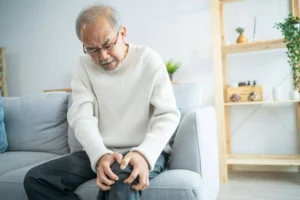Osteoarthritis (OA) is a common joint disorder affecting millions of seniors, leading to pain, stiffness, and reduced mobility. As we age, the likelihood of developing osteoarthritis increases, making effective management essential to maintaining quality of life and functional independence. Physical therapy offers a range of benefits that can help seniors manage osteoarthritis symptoms, enhance their mobility, and improve their overall well-being. In this blog, we’ll explore how physical therapy plays a critical role in managing osteoarthritis for older adults.

What is Osteoarthritis?
Osteoarthritis is a degenerative joint disease characterized by the breakdown of cartilage—the protective tissue that cushions the ends of bones. As the cartilage wears down, bones begin to rub against each other, leading to pain, inflammation, and reduced joint function. Commonly affected joints include the knees, hips, hands, and spine. Key symptoms include:
- Joint Pain: Persistent or intermittent pain, often worsened by activity and relieved by rest.
- Stiffness: Especially noticeable after periods of inactivity or in the morning.
- Swelling: Inflammation in and around the affected joint.
- Reduced Range of Motion: Difficulty moving the joint through its full range of motion.
The Role of Physical Therapy in Osteoarthritis Management
Physical therapy is a non-invasive treatment approach that focuses on improving function, reducing pain, and enhancing the overall quality of life for seniors with osteoarthritis. Here’s how physical therapy can be particularly beneficial:
1. Pain Management
Manual Therapy: Physical therapists use techniques such as joint mobilization and soft tissue massage to alleviate pain and improve joint function. These methods can help reduce muscle tension, increase blood flow, and decrease discomfort.
Therapeutic Modalities: Modalities like heat and cold therapy, electrical stimulation, and ultrasound are commonly used to manage pain and inflammation. Heat therapy can relax stiff muscles and improve circulation, while cold therapy can reduce swelling and numb the area.
2. Improving Joint Mobility
Range of Motion Exercises: To counteract stiffness and maintain flexibility, physical therapists design exercises that focus on improving the range of motion in affected joints. These exercises help keep the joint moving and prevent further restriction.
Stretching: Gentle stretching exercises can increase flexibility and reduce joint stiffness. Regular stretching helps maintain and improve joint health, making daily activities easier and less painful.
3. Strengthening Muscles
Targeted Strengthening Exercises: Strengthening the muscles around the affected joint is crucial for providing support and stability. Physical therapists create exercise programs that target these muscles to reduce the load on the joints and alleviate pain.
Low-Impact Activities: Low-impact exercises such as swimming, cycling, or using an elliptical machine are recommended to build strength without placing excessive stress on the joints. These activities help maintain overall fitness and joint function.
4. Enhancing Balance and Coordination
Balance Training: Osteoarthritis can impact balance and increase the risk of falls. Physical therapists incorporate balance training exercises to improve stability and reduce the risk of falls. These exercises enhance proprioception (the sense of body position) and strengthen the muscles involved in maintaining balance.
Coordination Exercises: Exercises that improve coordination help seniors perform daily tasks more effectively and safely, reducing the likelihood of accidents and injuries.
5. Education and Self-Management
Joint Protection Techniques: Physical therapists educate seniors on techniques to protect their joints during daily activities. This includes advice on proper body mechanics, using assistive devices, and modifying activities to reduce joint stress.
Activity Modification: Therapists provide guidance on how to adjust activities and incorporate joint-friendly practices into daily routines. This helps manage symptoms and prevent further joint damage.
Home Exercise Programs: A key component of physical therapy is the development of a home exercise program. Therapists provide exercises that can be done at home to maintain progress between therapy sessions and support long-term management of osteoarthritis.
How to Get Started with Physical Therapy for Osteoarthritis
If you or a loved one are considering physical therapy for managing osteoarthritis, here’s how to get started:
- Consult Your Healthcare Provider: Discuss physical therapy options with your physician to determine if it’s a suitable treatment for your condition.
- Find a Qualified Physical Therapist: Look for a physical therapist with experience in treating osteoarthritis, especially one specializing in geriatric care. In Jacksonville Beach, FL, Direct Orthopedic Therapy offers expert services tailored to seniors.
- Set Goals and Develop a Plan: Work with your therapist to establish clear goals and create a personalized treatment plan that addresses your specific needs and concerns.
- Commit to Your Therapy Program: Consistency is key to achieving the best results. Follow your therapist’s recommendations and stay dedicated to your exercise and self-management plan.
Conclusion
Physical therapy is a valuable tool for managing osteoarthritis in seniors, offering pain relief, improved mobility, muscle strengthening, and education on self-management. By addressing the symptoms of osteoarthritis and enhancing overall function, physical therapy helps seniors maintain their independence and enjoy a higher quality of life. If you’re ready to explore how physical therapy can benefit you or a loved one, contact Direct Orthopedic Therapy in Jacksonville Beach, FL, to learn more about our specialized services.


